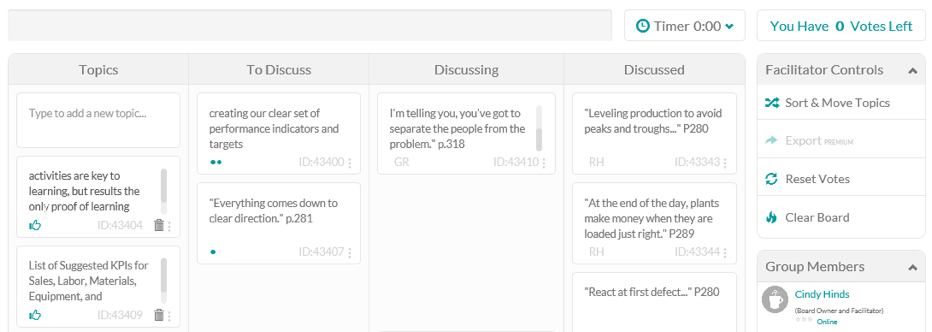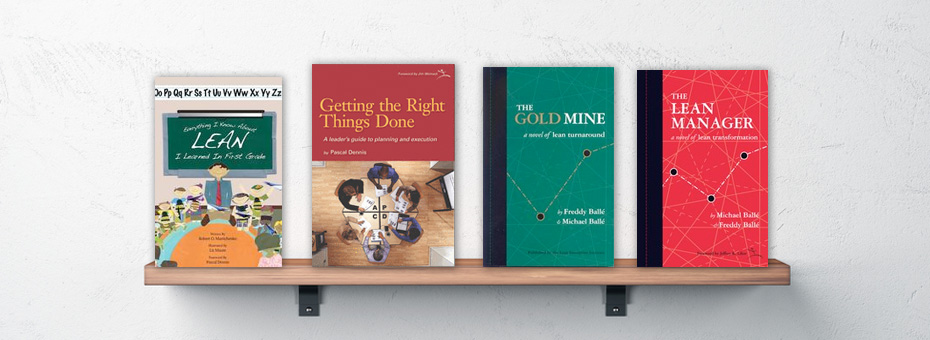If you are having difficulty getting your senior leadership team on board with a lean transformation, take a tip from Cindy Hinds, a continuous improvement leader at A.O. Smith Water Product Company. Start a book club with them.
Of the 14 divisional vice presidents in the club, “only two or three” had experience with lean transformations. “We were really starting from ground zero,” recalled Hinds, who is operating system director of the North America Water Heating business unit. “We had a lot of misconceptions and a lot of questions.”
She had to get everyone on the same page if the division, which had “pockets of lean,” was going to succeed at making lean management its business system. Hinds, who had been through lean transformations at previous employers, had learned a key lesson that she applied to starting the club.
“I’d been in positions before as a CI leader or a CI manager where I was pushing a lean agenda,” she recalled. “What I found was that it never worked. I ended up frustrated. I ended up being seen as a bulldozer pushing a program and nothing ever really got done. This time, I’ve made a very concerted effort to ensure that this was leadership’s agenda, not mine.”
In the following Q&A, she explains exactly what she did and why, and what business benefits the club is delivering.
Q: Why and when did the club begin?
Cindy Hinds: The book club began in late July 2017. We were in the beginning stages of introducing our leadership to lean concepts and I happened upon Michael Ballé’s webinar on how and why to start a book club. I loved the idea, so I convinced my organization’s president to sponsor a book club.
We started out every two weeks or so, as it was initially difficult to get on everyone’s calendar, but after two months or so, we began a regular weekly cadence. There are 14 staff members in four different physical office locations and others that spend the majority of their time traveling, so having everyone together at the same time is quite challenging.
Q: How does it work? Do readers interact as a group in some way, is there a facilitator for each book or chapter, how are books selected, are discussions recorded or notes archived, etc.?
Cindy: We are leveraging a tool called leancoffeetable.com to help us with the fact that the entire team is rarely in the room at the same time (see screenshot below). The question is the same for each week: “During your reading, what did you find interesting or want to learn more about?”

A screenshot of a page from leancoffeetable.com
Prior to the meeting, the participants fill in the topics, usually represented by a sentence in the book, along with a page number. During the first few minutes of the meeting, all participants, even those participating in person, vote on which topics they would like to discuss. The tool then allows us to sort the topics by most popular.
I will occasionally throw a “grenade” in the middle of the table – a question that I think will be controversial or challenging…We set a five-minute timer and then move the topic to the “discussing” column. I typically facilitate the call, but the tool is so straightforward, if I am unavailable, I pass the facilitator torch and other participants do it. The participants talk for five minutes. If the conversation slows down, When the five minutes are up, the team votes whether to extend the conversation or move onto the next topic. We continue in this vein until our hour is up. We have yet to run out of topics.
I pick books that I believe are effective at presenting the information that my leadership needs based on their knowledge and experience and where we are in our journey. I had also seen a roadmap from the LEI website that contained recommended books and workshops, so I started there. Sometimes we read an entire book for discussion (Everything I Know About Lean I Learned in First Grade), sometimes we take a chapter each week (The Gold Mine, The Lean Manager), and sometimes we will do two chapters a week (Getting the Right Things Done). It depends on the depth of the content and the time required to complete the reading.
Discussions and notes are not archived. I tried that for a while but saw no value in the documentation. Those who were not able to participate during a book club session would not be able to gain the insights and nuances of the discussion from notes or documentation.
Q: Have you found that certain types of books work best for the club, such as how-to workbooks, business novels, corporate nonfiction, etc.?
Cindy: The group enjoys how-to books best, followed by business novels. I have not introduced the larger case studies or deeper practitioner-style books. I do not believe that they are at that point in the journey.
Q: Currently, is the group just for executives?
Cindy: The book club that I facilitate is just for executives, but there are several that have taken the idea and started book clubs with their own staff. There are also others in the organization that are simply excited about lean concepts and have started their own book clubs. We also have a few executives who are not on this part of the organization’s staff but are kept in the loop, so they call in when able and are sent the books when we start new ones.
Q: What are the benefits of the club? For example, does personal development through reading and discussion lead to company development; does it help build a lean management culture, create space for deep discussions, or develop a common understanding of lean thinking and practice>
Cindy: Yes, to everything you asked. But, I believe that there are benefits that I never imagined out of this book club. I started simply because I needed to introduce lean thinking concepts to people who had never been exposed to them before. I needed them to begin to understand why the thinking and behavior of leaders in lean cultures are fundamentally different than those in traditional American manufacturing.
I also needed them to be able to see how our culture already values many of these same ideas and that lean thinking is simply the next evolution of who we are as an organization. But, I needed to do it in a way that didn’t have me spending hours droning on and on about my knowledge and experiences, since this is a bad way to teach. I needed them to experience these ideas for themselves, but it needed to be done in a relatively safe space. I am working with a very tight need team that has a high trust quotient. This allowed me to let them challenge each other on the concepts they were learning and how it is applied to who they are as leaders.
This book club does all of the things that you outline above and more. As members learn together, they grow together, they challenge each other, and they develop a belief in the process and ideals of lean. No amount of preaching and teaching from me could have done that.
As they grow in their knowledge of lean thinking, we are making changes to our methods (strategy deployment) and beginning to conduct observations which are deepening their learning even further and allowing them to apply and test the theories that they have been reading about. They are beginning to ask questions differently and change their language.
Q: From your experience, what are the key suggestions – the dos, don’ts, and maybes – for other managers and CI professionals who want to start a book club?
Cindy: Dos:
- Get a strong sponsor. It is their book club. They set the expectations for attendance and participation.
- Start with “easy reads” that introduce concepts in a simple and accessible manner. Not every leader in the organization needs to be a lean expert right from the beginning.
- Pick books that address a current need or problem that you are trying to solve. We jumped into Getting The Right Things Done after The Gold Mine because we were beginning to talk about next year’s strategy deployment process. Then, we picked up with the Lean Manager after that.
- Be cognizant of the time commitment of the participants. Leverage audiobooks where available.
- Be a mindful facilitator:
- Pay attention to the energy level in the room – don’t keep pushing participants to move on to the next topic just because you are.
- Hold white space. Let there be silence after asking the question. Give the participants time to think about their answers.
- Be flexible. If the participants have a critical business need that they are attending to, it is okay to cancel a meeting here or there.
- Find ways to allow participation from a distance. Video chats and online tools allow for fuller participation than just call-in numbers.
- Be a coach. Ask empowering questions and stay in close touch with the agenda of your leadership.
- Be on the lookout for the next book. Be a voracious reader. Leverage the recommendations of lean thought leaders to find books that work for your group.
Don’t:
- As the facilitator, don’t feel like you have to have all the answers. It is their book club, let them challenge each other. It is okay to say, “I don’t know.”
- Don’t get frustrated if the participants don’t immediately run out and change their behaviors. This is part of their journey and is just the first step in concept introduction.
- Don’t let the leaders run and implement based on a single tool or idea that they have read about. Coach them through the pitfalls of “tool only” implementation without the thinking and support structure to sustain it.
- Don’t focus on the tools at first, unless it is specifically what your team or business needs. Focus on the thinking first and the need for the tools will arise as they see the waste.
Q: How do you move executives from reading to acting? Is there “homework” after a book, such as starting regular gemba walks, leading monthly kaizens, or doing more coaching and less telling?
Cindy: There is no official homework stemming from the book club. I had to hold club participants back at first because they were hearing about tools and wanted to run and apply them. I purposely stayed away from letting them debrief during book club meetings on specifically how to apply what they were talking about. I wanted to make sure that we had gotten far enough into the learning that they weren’t trying to force tools on their employees without understanding the thinking behind the application of the tools.
Now, I am looking to the early adopters and deep thinkers to start initiating ideas on how to apply it in their own work. The only change that is being “forced” on them is how we conduct our monthly reviews of strategy deployment initiatives. I have been teaching them about coaching and the monthly report out is now taking the form of a coaching kata practice. They are also beginning to do more gemba walks and observation activities in alignment with these strategic initiatives. They are beginning to change how they do their work and achieve their objectives by using more coaching and a PDCA mindset.






